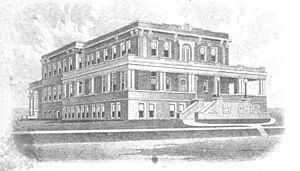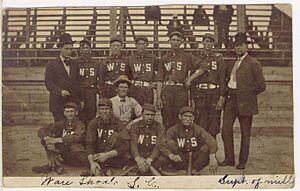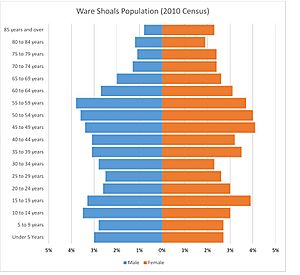Ware Shoals, South Carolina facts for kids
Quick facts for kids
Ware Shoals
|
|
|---|---|
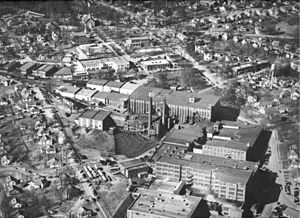
A bird's eye view of the mill in the 1950s. Katherine Hall is seen just behind the mill.
|
|
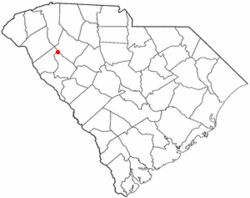
Location within the state of South Carolina
|
|
| Country | |
| State | South Carolina |
| Counties | Greenwood, Abbeville, Laurens |
| Area | |
| • Total | 3.37 sq mi (8.73 km2) |
| • Land | 3.28 sq mi (8.49 km2) |
| • Water | 0.09 sq mi (0.24 km2) |
| Elevation | 633 ft (193 m) |
| Population
(2020)
|
|
| • Total | 1,701 |
| • Density | 519.07/sq mi (200.42/km2) |
| Time zone | UTC-5 (Eastern (EST)) |
| • Summer (DST) | UTC-4 (EDT) |
| ZIP code |
29692
|
| Area codes | 864, 821 |
| FIPS code | 45-74680 |
| GNIS feature ID | 1251323 |
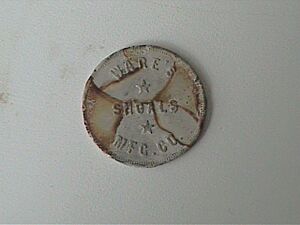
Ware Shoals is a town located in South Carolina, a state in the United States. It sits along the Saluda River and is unique because it's in three different counties: Abbeville, Greenwood, and Laurens. In 2020, about 1,701 people lived there.
The part of Ware Shoals in Greenwood County is considered part of the larger Greenwood Micropolitan Statistical Area. The Laurens County part is connected to the Greenville-Mauldin-Easley Metropolitan Statistical Area. This means the town is part of bigger economic and population areas.
Contents
Where is Ware Shoals Located?
Ware Shoals is found at 34°23′48″N 82°14′42″W / 34.39667°N 82.24500°W.
The United States Census Bureau says the town covers about 3.37 square miles (8.73 square kilometers). Most of this area is land, with a small part being water.
Who Lives in Ware Shoals?
| Historical population | |||
|---|---|---|---|
| Census | Pop. | %± | |
| 1970 | 2,480 | — | |
| 1980 | 2,370 | −4.4% | |
| 1990 | 2,497 | 5.4% | |
| 2000 | 2,363 | −5.4% | |
| 2010 | 2,170 | −8.2% | |
| 2020 | 1,702 | −21.6% | |
| 2022 (est.) | 1,698 | −21.8% | |
| U.S. Decennial Census | |||
Ware Shoals Population in 2020
In 2020, there were 1,701 people living in Ware Shoals. These people made up 977 households, with 633 of them being families.
Here's a quick look at the different groups of people living in Ware Shoals in 2020:
| Group | Number | Percentage |
|---|---|---|
| White (not Hispanic) | 1,143 | 67.2% |
| Black or African American (not Hispanic) | 397 | 23.34% |
| Native American | 4 | 0.24% |
| Asian | 9 | 0.53% |
| Other/Mixed | 101 | 5.94% |
| Hispanic or Latino | 47 | 2.76% |
Ware Shoals Population in 2010
In 2010, the town had a population of 2,170 people. There were 880 households.
- About 26.1% of households had children under 18.
- 39.2% were married couples.
- The average household had 2.38 people.
The average age of people in Ware Shoals in 2010 was 42.2 years old.
The median household income in Ware Shoals was $33,650 per year. This was lower than the national average. About 32.1% of the people in Ware Shoals lived in poverty. Because of this, the local primary and elementary middle schools are Title I schools, which means they get extra federal funding to help students from low-income families.
The History of Ware Shoals
Ware Shoals gets its name from an old water wheel gristmill that William Ware ran in the early 1800s. This mill was located on the Saluda River.
Building the Mill Town
A man named Senator Nathaniel Barksdale Dial had an idea to build a dam on the river. This dam would power a cotton mill. He started the project, but ran out of money.
Then, Benjamin D. Riegel bought the project in 1902. He started the Ware Shoals Manufacturing Company and officially founded the town of Ware Shoals.
- 1904: A power plant was finished. It provided 4,800 horsepower.
- 1906: A modern textile mill was built. It had 30,000 spindles for making thread.
- 1916: A new, bigger mill was built with 70,200 spindles and 1,300 looms.
The town grew very quickly. In 1904, only two men worked at the power plant. By 1916, 2,000 people lived in Ware Shoals. By the 1960s, the mill employed 5,000 people!
Community Life in Ware Shoals
The mill company, later called Riegel Textile Corporation, helped build the town. They provided:
- Electric lights
- Water and sewer systems
- Good streets
- A bank
- A railway
- An ice factory
- A cotton gin
- A cotton seed oil mill
Benjamin Riegel also helped start the town's first church. It was a union church, meaning different groups like Methodists and Presbyterians used it together. The Baptists built their own church.
Katherine Hall: The Community Center
The textile company built a large community center for $40,000. Benjamin Riegel wanted to call it "The People's Amusement Hall." But he was so proud of it that he named it Katherine Hall after his daughter.
Katherine Hall was a very important place in town. It had:
- A movie theater
- The community library
- A Masonic Lodge
- A pool hall
- A teen canteen
- Showers and dressing rooms for the public swimming pool next door.
The Company Store
The mill also ran a large department store, often called a "company store" in mill towns. It started small in 1906. By 1920, it was one of the best stores in the state.
The store had everything:
- A soda fountain for socializing
- A toy department
- A pharmacy
- A candy counter
- Sections for men's and ladies' clothes
- A furniture department
- A grocery store
- A cloth shop
Their motto was, "You can buy in one store anything from a paper and pen to a Ford automobile, from a baby girl's rattle to her wedding dress." The store closed in 1963. Today, the town's City Hall is located in this historic building.
Schools and Sports
In 1926, a large school building was built for white students. This building is still used today as Ware Shoals High School, making it one of the oldest school buildings still in use in South Carolina.
Riegel Stadium was built in 1931. It was first used for football games in 1934. Lights were added a year later for night games. The stadium has hosted:
- High school teams
- Textile baseball leagues
- Negro baseball leagues
- In 1954, it even hosted a game between professional baseball teams, the Cincinnati Red Legs and The Washington Senators.
In the 1950s, the Emma Maddox School was built for African American students. Emma Maddox was a respected teacher and principal. When public schools became integrated in 1969, Emma Maddox School became the middle school for all students in the community. The Emma Maddox Building of the current Ware Shoals Middle School is named in her honor.
Art and Movies
In 1939, an artist named Alice Kindler was hired by the WPA to paint a mural for the local post office. The WPA was a New Deal agency that created jobs during the Great Depression. The mural, called American Landscape, was finished in 1940.
Part of the movie Leatherheads was filmed in Ware Shoals.
The Ware Shoals Inn is a historic building in town. It was added to the National Register of Historic Places in 2007.
Education in Ware Shoals
Ware Shoals is part of Greenwood School District 51, also known as the Ware Shoals School District. This district serves students from all three counties that Ware Shoals is in.
The district has three schools:
- Ware Shoals Primary School
- Ware Shoals Elementary Middle School
- Ware Shoals High School
The high school library is special because it also serves as a public library for the community, as a branch of the Greenwood County Library System.
Famous People from Ware Shoals
- Lou Brissie (1924–2013): A baseball pitcher for the Philadelphia Athletics.
- Jerry Butler (born 1957): A former NFL wide receiver.
- Jeff Duncan (born January 7, 1966): A member of the U.S. House of Representatives for South Carolina's 3rd congressional district.
Images for kids
See also
 In Spanish: Ware Shoals para niños
In Spanish: Ware Shoals para niños



